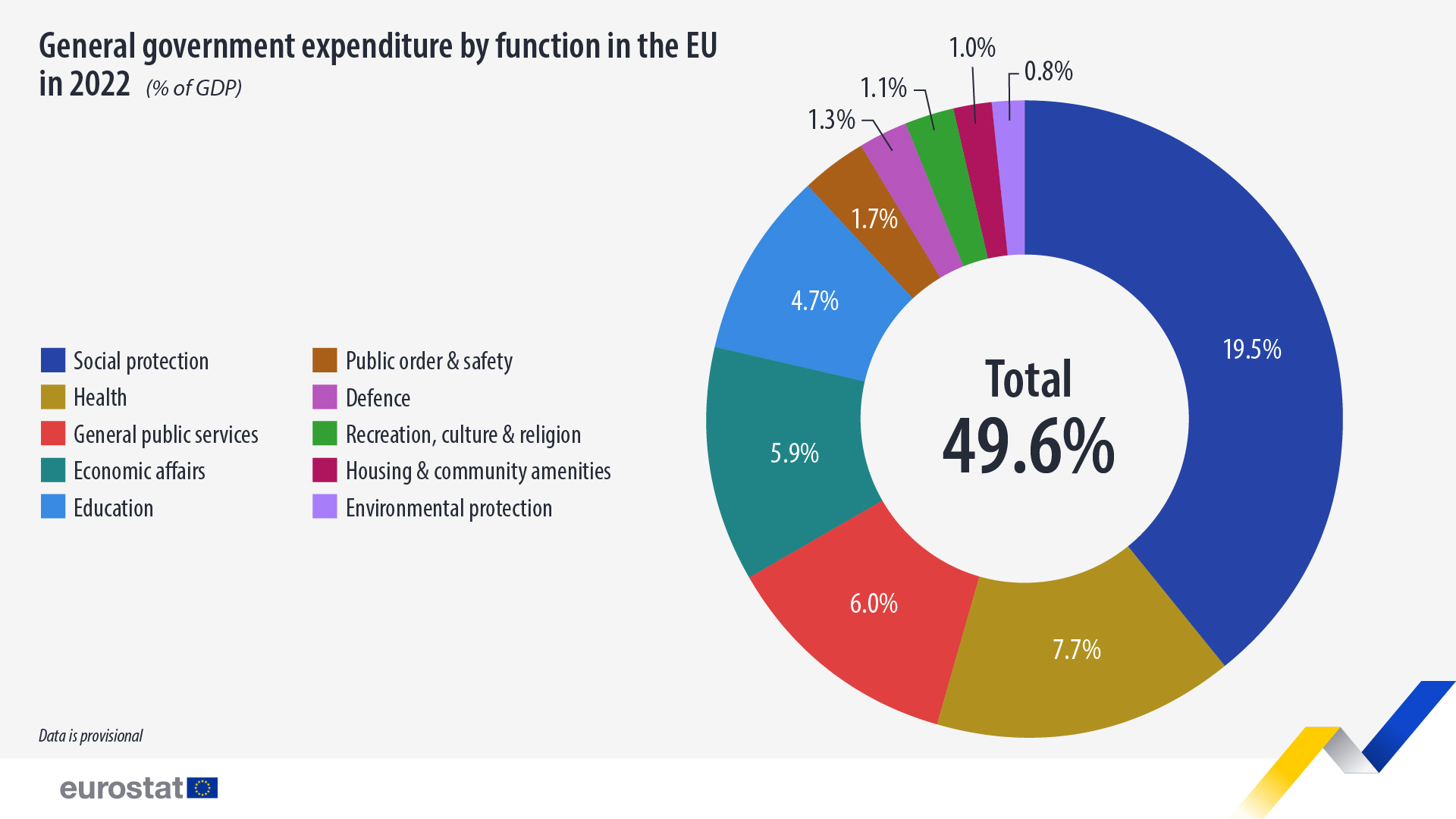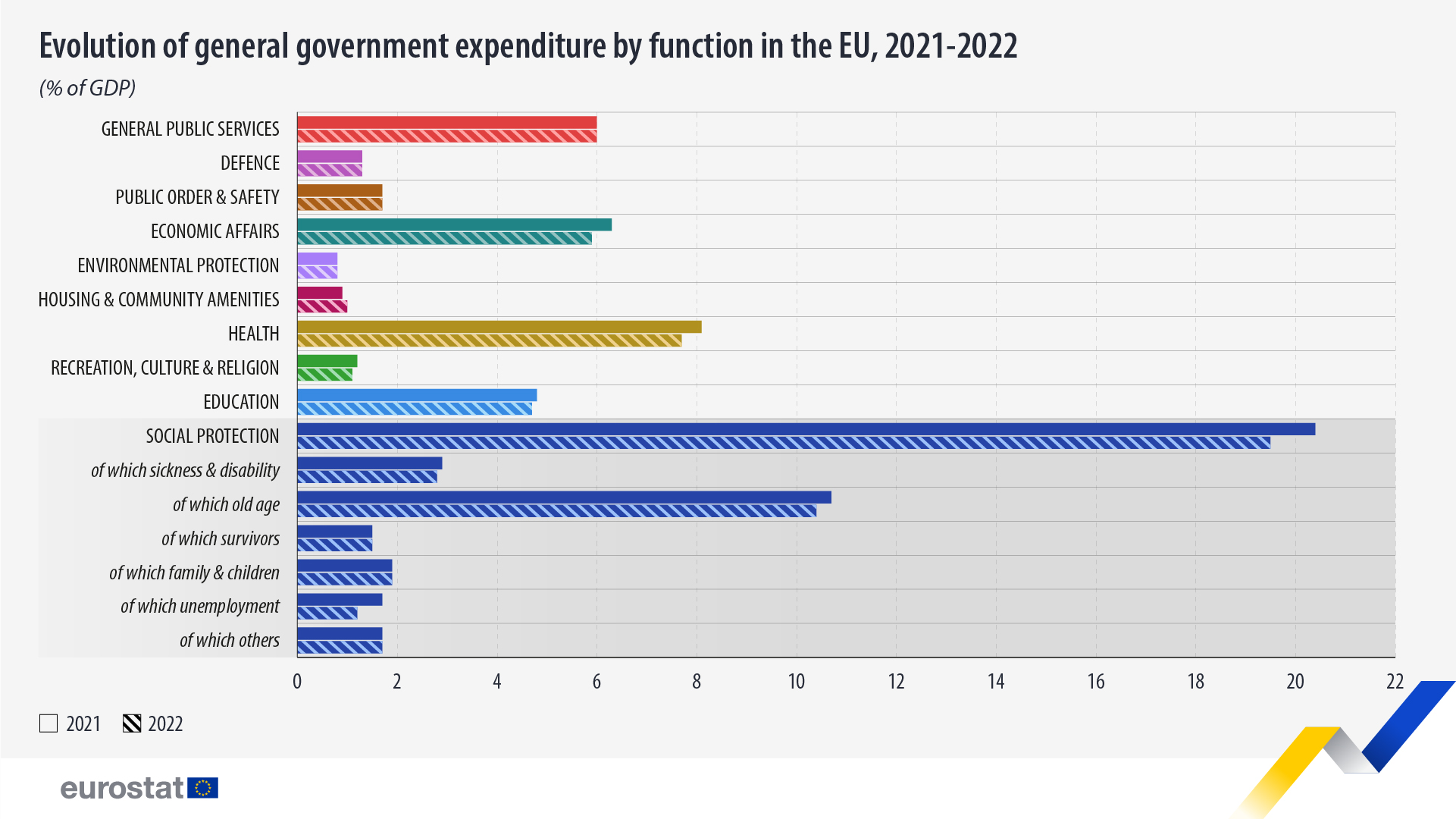General government expenditure by function in 2022

In 2022, the general government total expenditure in the EU amounted to 49.6% of gross domestic product (GDP). It was still influenced by the government measures aimed at mitigating COVID-19 pandemic effects, although to a lesser extent than in 2020 and 2021. On the other hand, government measures to mitigate the impact of increasing energy prices strongly influenced the level and composition of government expenditure. The decrease in the ratio to GDP compared with the previous year (51.3%) was mainly a consequence of increases in GDP, while growth in total expenditure was still observed (€7 894 billion in 2022 compared with €7 516 billion in 2021; an increase of €377 billion and a growth of 5.0% compared with 2021).
This information comes from recently published data on general government expenditure by function. This article presents only a handful of findings from the more detailed set of Statistics Explained articles.
Social protection and health – highest share of government expenditure
Among the main functions of general government expenditure in the EU, social protection remained the most important in 2022, equivalent to 19.5% of GDP. The next most important areas were health (7.7% of GDP), general public services (6.0%), such as external affairs and public debt transactions, economic affairs (5.9%), and education (4.7%). The functions public order and safety (1.7% of GDP), defence (1.3%), recreation, culture and religion (1.1%), housing and community amenities (1.0%) and environmental protection (0.8%) had more limited weights.

Source dataset: gov_10a_exp
Strong increases in social protection, general public services, education and health
At EU level, general government total expenditure increased for all the major functions. There was a +€113 billion increase in social protection. General public services also registered a strong increase (+€82 billion), as did education (+€43 billion) and health (+€39 billion).
The strongest relative increases were observed for housing and community amenities (+20.5%), and defence (+10.5%).

Source dataset: gov_10a_exp
Ratio of social protection expenditure highest in France and Finland, lowest in Ireland
Social protection represented the most important area of general government expenditure in 2022 for all the EU countries. Government social protection expenditure as a percentage of GDP varied from 7.5% of GDP in Ireland, 10.1% in Malta, 11.8% in Cyprus and 12.7% in Estonia, to 23.8% of GDP in France, 23.6% in Finland and 21.9% in Italy.
Government expenditure on health highest in Austria, on economic affairs in Hungary, on education in Belgium and Sweden
In 2022, Austria (9.3% of GDP), Czechia and France (both 9.1% of GDP) recorded the highest ratios of government expenditure to GDP devoted to health among the EU members.
The highest ratios of government expenditure to GDP on economic affairs in 2022 were recorded in Hungary (10.5%), ahead of Greece (10.0%).
The highest ratios of government expenditure to GDP on general public services were observed in Italy (8.6%), Hungary (8.2%) and Finland (7.8%).
For education, the highest ratios to GDP were registered in Belgium and Sweden (both 6.3% of GDP), followed by Estonia (5.8% of GDP).
For more information
- Set of Statistics Explained articles on government expenditure by function
- Interactive visualisation on government expenditure by function
- Thematic section on government finance
- Database on government finance
- Metadata on general government expenditure by function
Methodological notes
- While a significant effort was undertaken to harmonise the recording of government measures to alleviate the impact of increasing energy prices, a full harmonisation of data for the reference year 2022 was not yet achieved. Data are provisional.
- Administrative expenditure data is additionally collected in so-called satellite accounts. In general, the amount of expenditure recorded in satellite accounts is expected to exceed the expenditure recorded under the respective COFOG division. More details on the comparability of COFOG data with satellite accounts data can be found in the COFOG manual.
If you have any queries, please visit our contact us page.
